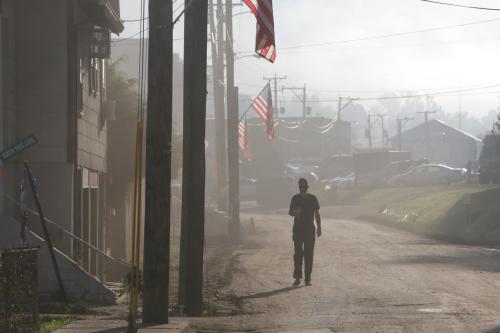In previous work, Anne Case and Angus Deaton of Princeton described a disturbing trend, the now-widely recognized rise in “deaths of despair” – suicides, drug overdoses, and alcohol-related liver disease – since the mid-1990s. For a time, this phenomenon was hidden in overall mortality figures because of improvements in treating heart disease, but that progress stalled around 2010 for those without a bachelor’s degree. In their latest BPEA paper, Case and Deaton show that life expectancy for adults without a BA has been on the decline for almost a decade. On this episode of the Brookings Podcast on Economic Activity, Case discusses the new findings with Carol Graham of Brookings.
- Listen to the Brookings Podcast on Economic Activity on Apple, Spotify, or wherever you like to get podcasts.
- Learn about other Brookings podcasts from the Brookings Podcast Network.
- Sign up for the podcasts newsletter for occasional updates on featured episodes and new shows.
- Send feedback email to [email protected].
TRANSCRIPT
[music]
EBERLY: I’m Jan Eberly, James R. and Helen D. Russell Professor of Finance at Northwestern University.
STEINSSON: And I’m Jón Steinsson, Chancellor’s Professor of Economics at the University of California, Berkeley.
EBERLY: We’re the coeditors of the Brookings Papers on Economic Activity, a semiannual academic conference and journal that pairs rigorous research with real time policy analysis to address the most urgent economic challenges of the day.
STEINSSON: And this is the Brookings Podcast on Economic Activity, where we share conversations with leading economists on the research they do and how it will affect economic policy.
EBERLY: Hello and welcome to season three of the podcast. I’m very excited to return as co-host this season and to welcome my new co-host, Jón Steinsson, who started as coeditor of the Brookings Papers this year. Welcome, Jón. I’m looking forward to discussing these papers with you.
STEINSSON: Thank you, Jan. I’m happy to be joining you and excited to share these fascinating conversations with BPEA authors and Brookings economists. The new research in this edition is particularly timely, with studies on major current issues, including supply chain dynamics, wage price spirals, global effects of U.S. monetary policy, and the great German gas debate.
EBERLY: I completely agree. This edition covers a lot of ground. So let’s jump into our first discussion. In this episode, we’ll hear from Carol Graham, senior fellow at Brookings, and Anne Case, the Alexander Stewart 1886 Professor of Economics and Public Affairs emeritus of Princeton University. They’ll be discussing Anne’s new paper, “Accounting for the widening mortality gap between American adults with and without a B.A.,” which she coauthored with Angus Deaton, also of Princeton. Jón, as you know, Anne and Angus have been working on this issue for a long time. How do you think this study fits into their larger body of work?
STEINSSON: Yes. Anne and Angus wrote this very influential BPEA paper back in 2017 titled “Mortality and morbidity in the 21st century.” In that paper, they documented increasing rates of what they referred to as “deaths of despair.” That’s deaths due to drug overdoses, suicides and alcohol related diseases. They documented that that the increases in these deaths of despair was so great that the overall mortality rate for white non-Hispanics in the United States had stopped falling. So that mortality rate had been falling for over 100 years, but it had stopped and it was starting to increase.
They followed up that research with a book in 2020 titled Deaths of Despair. And this book was hugely successful in bringing attention to these issues. More recently, they focused on growing inequality and mortality across groups with different levels of education. And that’s what the current paper is about.
EBERLY: You know, after their last paper at BPEA, there was a lot of press coverage, as you know. It was a very successful paper. And Doonesbury actually was the one and only time a BPEA paper got coverage in the comics section of the paper.
We’ve all been avid readers of Anne and Angus’s earlier work, but this paper has many new results. But one that really struck me was the widening gap in mortality that has opened at even younger ages and then widens as people get older. So for the young, deaths due to the despair categories that you mentioned—suicides, drugs, and alcohol— have increased. And then for the young, there’s also rising deaths due to accidents like auto accidents and other violent deaths.
So it seems that the related behaviors that young people have been exhibiting also accumulate to more deaths later on, say, alcohol and drug use. Even if they don’t lead to mortality among younger people, they lead to early death from related causes in the older age groups.
So it’s a really sobering narrative, but it makes us think hard about the opportunity and policy in America, since their paper also shows that this is a uniquely American set of outcomes.
[music]
STEINSSON: Yeah, Jan, I totally agree. The results in this paper are really sobering, but Carol and Anne will have much more to say about these issues, so let’s turn it over to them.
GRAHAM: Hello, I’m Carol Graham. I’m senior fellow in Brookings Economic Studies Program and happy to have Anne Case with me today to discuss her book with her book, her paper with Angus Deaton on mortality gaps between adult Americans with and without a B.A., which she wrote for the BPEA conference, as you all know already. It’s a wonderful, wonderful paper, although slightly depressing.
And thank you very much, Anne, for joining me. And I have several questions I’m hoping you can elaborate for us, for the audience. And also I think there are questions in the paper that are raised and we still don’t know all the answers yet. So we have a lot to discuss in a short amount of time. But anyway, thanks for joining me and welcome.
CASE: Thank you. It’s great to be with you, Carol.
GRAHAM: So, first of all, your paper with Angus is both incredibly well done, which is not a surprise given the two authors, but also really depressing. And so there are lots of themes in the paper. Two of them stand out and one is the very, very large and growing gap between the haves and the have nots in America. And in this case, defined for very good reason as those with and without a B.A. And we’ll elaborate on that.
And then the other theme is that the that the increase in despair related deaths have what you first you first coined the term in your seminal paper with Angus. But these are premature deaths due to self-imposed poisonings, suicide, drug overdose. But that the increase in those deaths has been big enough to wipe out gains made in other things like defeating cancer and or better treating cardiovascular disease. Lots of things which were reducing our mortality rates before 2015.
But since then the lines have crossed, I would say, and we now have an increase in mortality rates and obviously of overwhelmingly in the non-B.A. category. So I was wondering if you could tell our listeners a little bit more about the two trends and how and why and when they intersect it.
CASE: As you know, since at least as far back as the mid-1990s, deaths from suicide, alcoholic liver disease and cirrhosis and especially from drug overdose have been increasing and increasing almost exclusively for Americans without a four year college degree, which as a shorthand we call the B.A. But it could be any four year degree.
For a couple of decades until the arrival of the street fentanyl, that increase was highly concentrated in the white community. The Black community saw mortality rates from drugs and alcohol continue to fall until 2013. Unfortunately, that has changed and I think we’ll return to that.
For a time, the increase in the deaths of despair flew under the radar because we were continuing to make progress against heart disease. So our progress against heart disease was the engine for overall mortality progress in the last third of the 20th century and into the new century. But sadly, that progress stopped cold around 2010 for people without a bachelor’s degree. And without that counterbalance of mortality falling because of progress against CBD, life expectancy fell for people without a B.A. for nearly a decade before COVID.
And that decade-long downturn in life expectancy for those without a B.A. went pretty much on marked unremarked upon by the press, by elected officials, because it was happening to the invisible people.
So in this paper, what we do is we look at the gap in life expectancy and the gap in mortality between people with and without a B.A. And we can divide the recent history up into three different segments. From the early 1990s until 2010, life expectancy was growing for both groups, but faster for people who went to college.
And then after 2010 but before COVID, life expectancy was actually moving in different directions. It continued to rise for people who went to college, but it started to fall and continued to fall for people without a B.A.
And then once COVID hit, life expectancy fell for both groups, but in a much more pronounced way for people without a B.A.
So in all three periods that we lay out in this paper, the gap in adult life expectancy grew from a little more than 2 years in the early 1990s, to 5 years at the eve of COVID, and more than 7 years by the end of 2021.
And before we move on, I just want to make note of the fact that that decade-long decline in life expectancy for people without a B.A. from 2010 to 2020, when life expectancy was moving in different directions for these groups, that’s almost unheard of in modern times. The only other place that that was seen was in Eastern Europe just after the breakup of the Soviet Union, which gives you some sense of the company that the U.S. is currently keeping.
GRAHAM: Told you it was depressing. But anyway. So one clarification in this—so there was this rise in deaths to despair. But you also mentioned that the improvement in treating cardiovascular disease actually stopped for less than B.A. people, but not for those with a B.A. And maybe could you talk a little bit more about that?
CASE: Sure, there was a slowdown in progress for people with a bachelor’s degree, but it’s actually started to move in the wrong direction altogether for people without a B.A.
And the underlying reasons for that are not totally understood. There are people who think that it’s primarily due to obesity. But you can, I’m sure, tell a story, but it would be a complicated story given that for several decades obesity rates were rising while mortality rates from cardiovascular disease were falling. So why suddenly the progress stopped is not well understood. It may have something to do with obesity. It may have something to do with people changing their behaviors.
Again, the progress that we saw starting in 1970 was due to two different reasons. One was medical, that suddenly on the market there were these extremely inexpensive, extremely effective antihypertensives which brought down people’s blood pressure. And at the same time people stopped smoking. So there was behavioral change and there was medical advance.
And, boy, things went very well for a very long time. And we are going to have to try to unpack why across all U.S. states at the same time suddenly progress flatlined. If it were just obesity, you would imagine that obesity rates are different in different states. So we might expect it not to be quite so synchronized. But there was a synchronized stop in that.
One of the things that’s interesting about looking at causes of death and the gap in life expectancy is that we have made magnificent progress against cancers, but that great progress has gone disproportionately to people with a B.A.
To take I think, an interesting example, historically it was the case that better educated women were more likely than less well-educated women to die of breast cancer and ovarian cancer. That’s changed. So as screenings and treatments improved for those things, the tables have turned. And now women without a bachelor’s degree are more likely to die of those. Historically, it was the case that because better educated women had fewer children, they had more menstrual cycles, putting them at higher risk of those forms of cancer. But it looks like either access to screening or take up of screening, access to meds, take up of meds, those things have changed. And the gap between the better and less well-educated has risen, even though the risk of dying of these things has fallen.
GRAHAM: Isn’t that also this similar story and things like maternal mortality, right, where it’s less educated and often African American women have the highest rates of maternal mortality. And there’s a little bit of a puzzle there, too, except that we know they are less likely to get good care. But again, that seems like a pretty basic—childbirth is not exactly a high end point of medicine. It’s pretty standard. And yet there big gaps between the educated and less educated in terms of what they receive.
CASE: Yeah, and that is a crime, and that is a shame. The U.S. has nothing to be proud of in terms of our maternal mortality numbers. And it’s alarming that these are moving in the wrong direction again.
GRAHAM: Okay. Well, I have a slightly different question, which is you raised the point in the introduction of fentanyl. But I am wondering, still trying to uncover and why there’s been such a big change. In other words, you noted that the deaths of despair were primarily concentrated among non-Hispanic whites due to opioids. And yet in 2013 or so, boom, enter fentanyl, which is widely available, very lethal, very cheap. And all of the sudden you have a much bigger representation of minorities, particularly urban Black men, in the deaths of despair. And is it just a supply issue, is it just fentanyl? Or is there any evidence of increases in despair which have led to more? In other words, broader increases in despair as well as in deaths of despair which have led to more seeking of fentanyl, or is it just fentanyl availability?
CASE: I think there are a number of things going on. One thing that we document in a different paper—and we wrote a paper for the Annual Review of Economics back in 2021—and there we document that after so many years of progress against not only drugs but alcohol that around about 2013, both for Blacks and for Hispanics, rates of suicide are rising. Rates of death from alcoholic liver disease and cirrhosis are rising. Those are small relative to drug overdose. But all three of those have started to rise.
So it strikes me that it’s not just the supply of fentanyl, but that perhaps something in addition to that is going on. Fentanyl, as you know, is something that can be mixed with heroin. It’s something that can be mixed with meth or with cocaine, and in all cases making them potentially lethal.
There were approximately a million people in the U.S. who were stable on heroin before the arrival of fentanyl. So if I’m someone who’s stable on heroin and suddenly my supply is being mixed with fentanyl and perhaps without my knowledge, I’m suddenly at much higher risk than I would have been before. So fentanyl is just a scourge, and it’s hard to know how we’re going to get our arms around that. But we’re going to have to get our arms around that.
GRAHAM: Isn’t it the case that also because fentanyl is largely black market, that when you get a batch of fentanyl you don’t know how strong it is, or you don’t know how lethal it is until it’s too late?
CASE: Although I believe on the streets now, there are some testing kits so that you can find out how dangerous your drug is. Now, you can imagine there are a number of different opinions on whether or not that kind of testing should be done because it saves lives or shouldn’t be done because it might encourage people to take drugs when otherwise they may not if they thought it was potentially lethal. But it is the case that there are some screens now which could be applied, which might actually save an enormous number of lives.
GRAHAM: I hope so. Although I’ve also read some, albeit anecdotal, stories of when people are strongly addicted to these things and they hear about a very strong batch of fentanyl, which may have resulted in overdose among somebody in the community they’re in, and they actually seek out the same batch because it’s very powerful.
CASE: Oh, absolutely. There was a series of articles, I believe in the Washington Post on this—right?—that actually talked about the fact that talking to someone who was in active addiction saying to them, if it doesn’t have fentanyl in it, I’m not interested. So people in active addiction are not in a position to make good choices. But not everyone would be seeking out a level of fentanyl that would potentially kill them.
GRAHAM: One last question related to this whole fentanyl issue. When we look at the trends in 2020 through, say, 2022, it looks like suicides, reported suicides, remained roughly flat. There was not a big increase, but there was a huge increase in overdose deaths. But the estimates I’ve seen for overdose deaths, which are intentional versus not intentional—right?—are between 15 and 60%. So we really don’t have a good handle on the extent to which overdose deaths sort of substituted for suicide. Or do we? Do you have any thoughts on that?
CASE: No, It’s very hard for the coroner or the medical examiner to know the intent. In fact, there was a study that was done in an ED in Flint, Michigan, where having brought people back from drug overdoses a survey team asked them whether or not their intent was to kill themselves. And a very large minority of those people said they didn’t know. So if the person themselves doesn’t know whether or not they’re trying to kill themselves, it’s a lot to put on the medical examiner or the coroner to actually make that decision.
During COVID, the other thing that happened, suicides fell in the first year, which may have been due to reasons that are related to why suicide falls in wartime, which is there’s a rally round kind of phenomenon going on. Suicides went back up in the second year of COVID.
The thing that skyrocketed also were deaths from alcoholism. So given that the liver is a robust organ that can take time for alcohol to have a really serious effect, I’m guessing that that is a signal that a lot of people who are in recovery went back to drinking during COVID. Because while it was on an upward trend from the late 1990s, there was a significant increase in the trend line during COVID. So, no, we don’t see reasons that this is necessarily going to get better unless we can work on some of the underlying issues that are responsible for it.
GRAHAM: Well, that’s a good lead in to my question, Anne, my next question, which is, I think, a really compelling reason to read the paper beyond it being a really good paper, is that you’re basically using the story of mortality trends in the U.S. to tell a bigger story, the sort of underlying story that you’re referring to about the different kinds of lives that the haves and the have nots lead in the U.S.
And I would argue or maybe add to that, that we’re pretty unique among rich countries in terms of how big that gap is. But I’m wondering if you can talk a little bit more about that, the sort of underlying story that you are referring to and seek to pull out in the paper a bit.
CASE: We use the distinction between people with and without a B.A. because that’s where we see a break in the action. People with some college but less than a B.A. look a lot more like people with a high school degree than they look like people with a B.A. And so that we use that break because it’s what the data say is the salient cut point there.
Which leads us to we’re not making the argument that somehow education is causal, that education through the improvement of your health behaviors that you learn because you have more education, that may play a role. But we are not arguing that that’s causal. What we’re saying is that it’s a marker for something. And we think that something, being economists, has a lot to do with the economic situation of the people who find themselves at risk.
Which takes us back to the labor market. Real wages for men with less than a B.A. have been on a long term downward trajectory since at least 1980. Real wages go up and down a bit with the business cycle, but the overall trend has been down. And at the same time, their attachment to the labor market, men without a B.A., has been on a long term downward trend since 1980. So attachment to the labor market has fallen. The number of good jobs, jobs with benefits, jobs with a ladder up, have been falling, which has knock on effects to life in general.
Our friends in Princeton, who have for several decades now been running something known as the Fragile Families Study, now known as the Future of Family Study, were telling us, the people in our study aren’t getting married. They say they can’t get married until one of them has a good job. And so there are cohabitations that don’t tend to be stable.
But marriage rates have gone through the floor for people without a B.A. For people with a B.A., there was a drop between 1980 and 1990, but since that time, people with a B.A. are getting married at the same rates that they were in, say, 1990s. From then until now, it’s been roughly constant.
People without a B.A. are less likely to be affiliated with any organized religion. And less connected to the community.
So we think that lack of connection to the labor market, a less stable home life, a less stable community life, those are what Durkheim and his tome on suicide that he wrote back in the end of the 19th century would have called “a recipe for suicide.” And we think that within that lies some of the seeds for what we’re seeing now in terms of people who feel that they want to find some way to soothe the beast. Some people do it with alcohol. Some people do it with drugs. Some people can’t bear it and end up taking their own lives.
GRAHAM: Yeah, I’ve done a little bit of looking at the state of reported well-being of prime age groups out of the labor force and the cohort that is the most desperate— least hope, most isolated, no attachments, no real family life, no community life—are prime-age white males out of the labor force. And I’m wondering if you have any thoughts on that. In my view, it comes from belonging to a cohort that used to have stable jobs, good wages, maybe not great wages, but they weren’t falling, and respected, blue collar, middle class lives. And they’ve, in a way, fallen further in relative terms than cohorts who were previously discriminated against, like minority men. I personally think that that may be one reason that they are so well represented, unfortunately, in this Durkheimian tale you’re telling.
CASE: But it’s also women. Right? So one of the things that drives us crazy, because the media gets us wrong more times than it gets it right, is this phenomenon of increasing deaths from all three causes—suicide, drug overdose, alcoholic liver disease. Women were less likely back in the day to die of any of those things, but their upward trends have been almost identical with those of men.
GRAHAM: Right, so they sort of started at a lower level. But the rate of change has been—
CASE: —the rate of change has been more or less the same. So I think what story we tell probably is a story that’s going to have to cover both men and women. But I think that the women also have less stable lives than they would have had in previous generations. They would have been in perhaps not great jobs, but good jobs and would have seen their prospects going up. They would have had more likely to been to be married and to be raising children within a marriage rather than raising children on their own or with someone who’s not the father of their children. They would have been more connected to their communities than they are now.
So it is something that both men and women are facing, and that especially for Black men and women without a B.A. are also finding themselves in a position where things are becoming less tenable.
GRAHAM: Well, I have one more question. In your Deaths of Despair book you have more space to spend more time on it, but you spend a lot of time on the U.S. health care system and its failings. And then you obviously hint at that and discuss it briefly in the paper. And I’m wondering if you might say a bit more about what you think the worst failings are. And I think there are different aspects of it. One is access, and we know there’s differential access. And cost is another one. But then there’s also a sort of a demand side to the story, which is things like differential levels of trust in science in some populations compared to others. And I’m sure it’s difficult to isolate what exactly the factor is. But I’m wondering what you think of in terms of all of them.
CASE: So I would say all of the above matter. But we make a pretty strong case that cost is one of the things that’s literally killing us. That our health care system spends more than twice per person what most other rich countries are spending, even though health and longevity is better in those countries than it is in the U.S.
And we like to say that people are dying here not in spite of what we’re spending on health care, but because of what we’re spending on the health care. If 1 dollar in 5 is going to the health care sector, is going to hospitals that are merging and raising prices, it’s going to device manufacturers and drug makers and physicians who are the largest single occupation in the top 1% of income earners, we’re not spending that money on things that that would be helpful to regular people to hold body and soul together.
One of the reasons we think that real wages have been falling for working class people is because of the crazy way that we fund our health care system. So in an employer-provided health insurance scheme, the one that we find ourselves in, where the amount the employer pays per worker is more or less a head tax—it varies very little whether or not that person is a window washer or sitting in the C-suite—that once an employer has to pay their share of the $20,000 a year premium for a family policy—and employers on average pay 70% of that—employers are going to look and say these low wage workers just aren’t worth it to us. We can’t both pay their health insurance premia and pay them anything that even looks like a minimum wage. So they outsource those jobs.
So jobs that might have historically led to better jobs—you start in the motor pool, you’re smart, you end up behind a desk; you’re smart, and a hard worker, you might end up somewhere in the administration. But those jobs are gone. You can’t find your way up that way anymore. And we think that the way both the cost of and the way that we finance our health care in this country has just taken a wrecking ball to the low-wage labor market and is in part responsible for the some of the underlying factors that have led to these premature deaths that we document.
GRAHAM: Well, it’s pushed a lot of people into the gig economy, presumably as well.
CASE: I don’t have an information about that, but certainly instead of being a cleaner who works for a very large hotel chain, now I work for the All Bright Cleaning Company. There’s no ladder up at the All Bright Cleaning Company. And if I miss too many days of work, I’m out, right? I have no job protection and really no future to see any improvement in my situation.
GRAHAM: Well, I hope the next paper you all write is about how we can get out of this. I mean, there’s some hints of it and certainly in our discussion. But it’s a really, really compelling story. The fact that the comparison case is Eastern Europe after the breakdown of the Soviet Union is not particularly hopeful at the moment. But I think your raising the awareness of the problem is a really good first step, and—
CASE: —can I end on a high note? Can I say something positive?
GRAHAM: That would be great.
CASE: All right. So the high note would be this. There is a move afoot to try to encourage, or if it’s a state government, enforce, that the requirements for a job come from the skill level needed and not from an educational certificate like a B.A.
So, for example, the state of Pennsylvania now for state jobs, you have to make a case for why this job a B.A., is necessary. And if it’s not necessary, it doesn’t go on the job description. And I think that some large employers have also gotten on that bandwagon and are trying hard to take people based on skill and not on certification like a B.A.
And there’s a new foundation called Paper Ceiling dot org. And they are trying very hard to push this case. Not everyone has to go to college and not everyone wants to go to college. But I think that another way into this problem would be to open the door when there’s no reason the door should be shut. And some people are actually moving in that direction.
GRAHAM: So are educators, because they’re starting to talk about the skills that students need rather than the degree they get parallel to that. So that’s also hopeful, or a parallel hopeful thought.
[music]
Well, thank you again, Anne, for the wonderful paper and discussion today, and we hope to have you back on the BPEA podcast soon.
CASE: Thanks very much.
STEINSSON: Once again, I’m Jón Steinsson.
EBERLY: And I’m Jan Eberly.
STEINSSON: And this has been the Brookings Podcast on Economic Activity. Thanks to our guests for this great conversation and be sure to subscribe to notifications about new releases of this podcast.
EBERLY: The Brookings Podcast on Economic Activity is produced by the Brookings Podcast Network. Learn more about this and our other podcasts at Brookings dot edu slash podcasts. Send feedback to podcasts at Brookings dot edu, and find out more about the Brookings Papers on economic activity online at Brookings dot edu slash BPEA.
STEINSSON: Thanks to the team that makes this podcast possible, including Kuwilileni Hauwanga, supervising producer; Fred Dews, producer; Gastón Reboredo, audio engineer; with the support from Shannon Meraw and Chris Miller of Economic Studies at Brookings. Show art was designed by Katie Merris at Brookings, and promotional support comes from our colleagues in Brookings Communications.
The Brookings Institution is committed to quality, independence, and impact.
We are supported by a diverse array of funders. In line with our values and policies, each Brookings publication represents the sole views of its author(s).











Commentary
PodcastWhy is life expectancy falling faster for adults without a BA?
October 12, 2023
Listen on
Brookings Podcast on Economic Activity